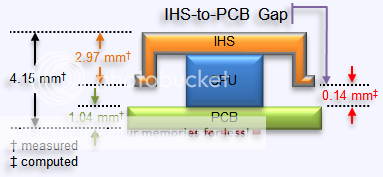- Jun 30, 2004
- 16,634
- 2,028
- 126
This could easily go in the CPU forum, but it's a cooling topic.
The recent IB (and now Haswell) de-lidding experiments showed some significant differences in thermal improvement, either by replacing the IHS lid or removing it entirely.
In earlier years, some people had lapped off the entire top layer of their IHS to expose the solder on the die (and hopefully nothing else).
Otherwise, any focus on the IHS is a matter of a copper intermediate layer and its thickness.
Consider the old "TCASE" spec. For certain processors (and TDPs) it had been either measured or estimated at about 10C below the core average, give or take. But it depends on the thickness of the layer.
So would eliminating half the thickness of the IHS through lapping yield a 5C improvement?
Lapping is worth at least a few degrees; nickel elimination is worth a few degrees. So I'm wondering about doubling or tripling the time I spend lapping a processor. And what is the best indicator that it's time to stop?
Probably a good reason to use a digital caliper . . .
The recent IB (and now Haswell) de-lidding experiments showed some significant differences in thermal improvement, either by replacing the IHS lid or removing it entirely.
In earlier years, some people had lapped off the entire top layer of their IHS to expose the solder on the die (and hopefully nothing else).
Otherwise, any focus on the IHS is a matter of a copper intermediate layer and its thickness.
Consider the old "TCASE" spec. For certain processors (and TDPs) it had been either measured or estimated at about 10C below the core average, give or take. But it depends on the thickness of the layer.
So would eliminating half the thickness of the IHS through lapping yield a 5C improvement?
Lapping is worth at least a few degrees; nickel elimination is worth a few degrees. So I'm wondering about doubling or tripling the time I spend lapping a processor. And what is the best indicator that it's time to stop?
Probably a good reason to use a digital caliper . . .



